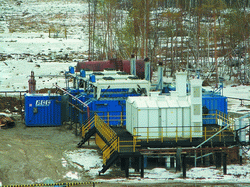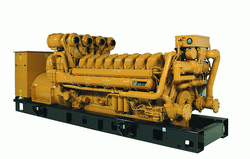Siemens Energy has secured an order for turnkey construction of a combined cycle power plant in Tessenderlo, Belgium. Purchaser is the independent power producer T-Power N.V., in which International Power plc, Siemens Project Ventures GmbH and Tessenderlo N.V. each hold a 33 percent stake. The order volume including a long term maintenance contract for the gas turbine is approximately EUR320 million.
The Tessenderlo 420-megawatt (MW) plant will be built in Flanders on the premises of Tessenderlo Chemie N.V. From mid-2011 the power plant will supply one-third of the power generated for the energy-intensive production processes at the neighboring chemicals plant, with the other two-thirds fed into the grid. Siemens Energy will build the power plant as a turnkey project and supply the main components comprising one gas turbine, one steam turbine and one generator, the entire mechanical equipment, and the electrical and I&C systems. The plant in Tessenderlo has a very flexible design and can thus be quickly modified to meet changed market conditions. The new plant is slated to meet intermediate and peak load demand.
Tessenderlo Chemie is also taking the opportunity to overhaul its entire high-voltage network. The order for this has gone to Siemens Energy Belgium, as head of a consortium with Pauwels International and Fabricom GTI. Siemens will take care of a new gas-insulated 150-kV distribution station to which the new plant will also be connected, a new 26-kV distribution station and the upgrade of a second station, as well as the associated protection panels and supervision systems. The consortium will also be responsible for the study, installation, commissioning and building engineering.
Combined cycle power plants are an important feature of Siemens environmental portfolio. In 2008, revenue from the products and solutions of Siemens environmental portfolio was nearly EUR 19 billion, which is equivalent to around a quarter of Siemens total revenue.

Новости
Rolls-Royce will deliver a further eight RB211 industrial gas turbines for Nigeria’s offshore oil and gas fields this year as part of contracts worth $150 million from TOTAL.
These units, for a Floating Production, Storage and Offloading (FPSO) vessel in the Usan field and a fixed offshore platform in the Ofon field, bring the total number of RB211s ordered by TOTAL for offshore Nigeria to 19.
Six of the RB211 gas turbine packages will be electrical generating sets, three for each field, to provide up to 160MW of electrical power for the new installations. All of the packages will also feature exhaust mounted waste heat recovery units.
The remaining two sets will be gas compression packages to export gas to another facility or to re-inject gas into the oil field to enhance oil recovery in the Usan field.
The new Usan oil field, 100 kilometres southeast of Bonny Island in water depths ranging from 750 to 850 metres, is scheduled to become operational in 2012, when production will be in the region of 180,000 barrels of oil per day.
Phase two of the Ofon oil field development will allow an increase in oil output from 25,000 barrels per day to around 100,000 in 2011. The gas produced from the Ofon field will be piped to the Amenam complex.
The packages for Usan and Ofon are due for delivery to the module fabrication yards by the fourth quarter of 2009.
Filter company, Jenbacher distributor in Byelorussia, commissioned gas engine power plant for Euroopt trading center under the turnkey contract.
The power plant consists of two JMS 312 GS-N.LC power units (manufactured by GE Energy Jenbacher gas engines) generating 526 kW of electric and 640 kW of thermal power. The fuel is natural gas. BROAD absorption chillers generate cold for climate control.
Trigeneration operation of the power plant provides trading centre with uninterrupted supply of electricity, heat and cold. The second stage on the base of 1063 kW JMS 320 GS power unit is scheduled for the end of the year.
 The customer for the project is Tomskneft-VNK JSC. Under government regulations dated 08.01.2009 oil producing companies are to increase casing-head gas utilization. Three P800 P1 diesel generators rated at 640 kW each manufactured by FG Wilson (Engineering) Ltd. have already been turned to dual-fuel operation on diesel fuel and diesel gas. Taking into account electrical load of the power plant, about 30-50% of primary fuel is being replaced.
The customer for the project is Tomskneft-VNK JSC. Under government regulations dated 08.01.2009 oil producing companies are to increase casing-head gas utilization. Three P800 P1 diesel generators rated at 640 kW each manufactured by FG Wilson (Engineering) Ltd. have already been turned to dual-fuel operation on diesel fuel and diesel gas. Taking into account electrical load of the power plant, about 30-50% of primary fuel is being replaced.
A.D.D. Service specialists have already carried out similar work at Zapadno-Krapivinskoye field and others. In the project they use the equipment by ComAp Systems, Czech Republic. Payback period is 10-14 months depending on the capacity of the power equipment.
The power plant supplies gold and silver mine in Chukotka Autonomous Area with heat and electric power. The project is realized by Bema Gold Corporation, Canadian gold-mining company. The power plant is designed on the base of four Wartsila 32 diesel generating sets equipped with 12V32 engines with the capacity of 5.3 MW each. The power units operate on special diesel fuel avoiding congelation at severe winter temperatures. Taking into consideration severe climate at the site the latest Wartsila developments were used in designing of the power units.
 Caterpillar Inc. announces the introduction of the C175-16 diesel package generator set for standby, prime and continuous applications. The generator set is available worldwide in 60 Hz packages with ratings up to 3.1 MW and 50 Hz packages with ratings up to 3.1 MVA. The Cat® C175-16 generator set package was designed to offer a larger unit rating, higher power density, lower emissions and reduced installation costs. Meeting U.S. EPA Tier 2 requirements, the new generator set addresses current and future needs of the worldwide electric power industry.
Caterpillar Inc. announces the introduction of the C175-16 diesel package generator set for standby, prime and continuous applications. The generator set is available worldwide in 60 Hz packages with ratings up to 3.1 MW and 50 Hz packages with ratings up to 3.1 MVA. The Cat® C175-16 generator set package was designed to offer a larger unit rating, higher power density, lower emissions and reduced installation costs. Meeting U.S. EPA Tier 2 requirements, the new generator set addresses current and future needs of the worldwide electric power industry.
Unveiled in 2006, C175 diesel generator sets have successfully completed rigorous field reliability demonstrations in real-world applications spanning the globe.
The C175 has been used for applications ranging from distributed generation to prime power for remote communities, industrial processing plants and rock crushing applications.
Five key engine systems comprise the Cat C175-16: fuel system, electronics and controls, air system, cooling system and lubrication system. Engineers incorporated significant input from Voice of Customer (VOC) market research into the design of the systems, allowing Caterpillar to deliver a world-class engine to customers seeking standby and prime power application solutions.
The C175-16's fuel system utilizes a high pressure fuel pump and control valve that deliver multiple precise injections within a single combustion event. This results in lower emissions, improved performance and reduced fuel consumption. Driven by the ADEM™ A4 controller, the C175-16 engine management system provides superior performance, even in the most demanding environments.
The air system delivers cooler combustion air at the cross-flow cylinder heads, allowing for higher power density and emission reduction. A new generation of turbochargers was designed for the C175, providing a 5 percent efficiency boost and longer life when compared to traditional turbochargers.
A newly designed cooling system cools only the parts of the engine that require cooling, resulting in increased efficiency and lower heat rejection. This method of temperature control allows customers to reduce overall operating costs by using smaller radiators.
The lubrication system utilizes Cat® Advanced High Efficiency Oil Filters which provide a higher level of filtration efficiency while maintaining Caterpillar's superior capacity.
Siemens Energy is to adapt its proprietary process for carbon dioxide capture to the special conditions prevalent in and mode of operation of combined-cycle power plants for the Norwegian utility Statkraft. The project kicked off in January 2009 and is scheduled to be completed within two years. This technology will then be available for industrial-scale applications.
Fossil energy will remain the cornerstone of power generation for the foreseeable future. The task to be performed here is to meet increasing energy demand while simultaneously protecting our environment.
Combined cycle power plants are in great demand throughout the world due to their high efficiency and low environmental impact. They do, however, impose stringent requirements on the process used for CO2 capture. Their flue gas has a lower CO2 concentration than that in coal-fired plants while simultaneously exhibiting a high oxygen content, conditions which have a very negative impact on known solvents.
The technology for CO2 capture from the flue gas of power plants is an important feature of the Siemens environmental portfolio. In 2008, revenue from the products and solutions of Siemens environmental portfolio was nearly EUR 19 billion, which is equivalent to around a quarter of Siemens total revenue.
